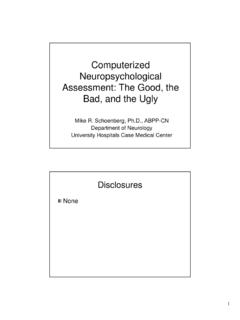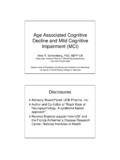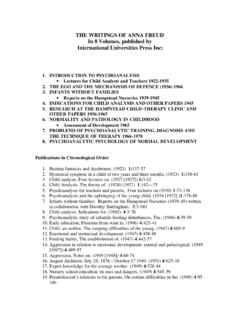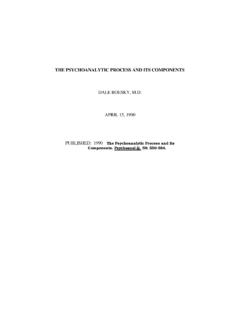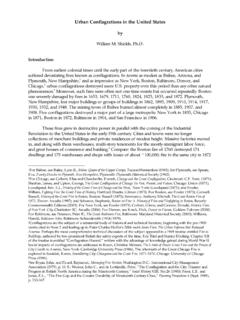Transcription of Suicide Assessment in the Elderly - Carter-Jenkins …
1 Suicide Assessment in the ElderlyGeriatric Psychiatric for the Primary Care Provider 2008 Lisa M. Brown, and Mental HealthLouis de la Parte Florida Mental Health InstituteUniversity of South FloridaA Typical ScenarioSuicide Facts Mental Health Clinicians have more than a 1 in 5 chance of having a patient commit suicideAverage of 1 American every 16 minutes2004 Official Data USA 32,000 people (89 per day) commit Suicide 11th leading cause of death in the USA Males, age 75 and older have the highest rates of Suicide (rate per 100,000) Suicide Facts Suicide is an intended death. It is done by oneself to oneself and can be indirect or passive Suicide attempters and completers are distinct but overlapping populationsSuicide Facts Women attempt Suicide more often than men Men complete Suicide more often than women at the rate of 4 to 1 Attempted Suicide United States, 2004 Source: CDC, NCHS - death certificates, Natl.
2 Hospital Discharge Survey, Hospital Ambulatory Care Medical Care Survey Crosby et al, 1999 DeathsHospitalizationsEmergencyDept visits32,000+154,598372,72215301,768,000 No treatment Sought60 NumberProportionSuicide Facts Firearms are the most common method of Suicide in the US, followed by hanging Suicide by firearms accounted for 57% of all suicides 71% of Suicide committed by older adults involve a firearm The risk of Suicide increases by nearly 5 times in homes with guns (Kellermann, 1992)High Rate of Male Suicide is a ProblemSuicide Facts Suicide risk is highest for depression, placing an individual at twenty-one times the expected risk, followed by bipolar disorder substance abuse schizophrenia personality disorders anxiety disordersOlder Adults The Elderly make up 12% of the population (US) but represent 16% of the suicides Among the highest rates (when categorized by gender and race) are Suicide deaths for white men over 85, who had a rate of 59/100,000 Suicide is a Risk Factor for Which Two DSM-IV Diagnosis?
3 Recurrent thoughts of death (not just fear of dying), recurrent suicidal ideation without a specific plan, or a Suicide attempt or a specific plan for committing Suicide Recurrent suicidal behavior, gestures, or threats, or self-mutilating behaviorAssessing Suicide RiskProblems in Assessing Suicide Risk No Assessment measure is sensitive enough to identify those that will commit Suicide and accurate enough to avoid false predictions Prediction of Suicide is impossible because it is a low base rate behavior with many risk factors that change with time and circumstancesProblems in Assessing Suicide RiskLiterature is full of risk factors Demographic Psychosocial Psychiatric and Medical MiscellaneousThe Hidden Danger of Early Stage Dementia A meta-analysis of 249 clinical studies to examine the level of Suicide risk associated with common mental disorders found All mental disorders.
4 With the exception of mental retardation and dementia, carried increased risk for Suicide (Harris and Barraclough, 1997) Assessment Compared to younger suicidal adults, researchers note that suicidal Elderly individuals demonstrate significant differences in risk factors, precipitating events, and predisposing variablesComparison of younger adults and the Elderly on variables relevant to suicidal behavior (McIntosh et al., 1994)DomainAdultsElderlyMethod of attemptGunshot woundGunshot woundMarital statusDivorcedWidowedPhysical healthStableDeterioratingAcute stressorsLimited financesHealth problems and social isolationComplicationsVariedVulnerableSe tting of attemptHomeHome aloneFrequency of ISDBO ccasionalCommonAlcohol AbuseOccasionalOccasionalCognitive focusFuturePastSpecial supportsVariableDiminishingDiagnosisDepr essionDepressionProblem-solving deficitsCommonCommonAssessment Different diagnoses ( , major depression, alcoholism and schizophrenia) have different clinical presentations, courses, prognoses, and treatments, so their risks for Suicide are also likely to differ (Clark and Fawcett, 1992)
5 Depression and Suicide Diagnosis most often associated with completed Suicide Clinically depressed mood is associated with 83% of Elderly suicides Patients who have had multiple episodes of depression are at greater risk for Suicide than those who have had a single episode Lifetime risk of Suicide for individuals with untreated depressive symptoms is approximately 15%Alcohol Dependence and Suicide Second most common diagnosis associated with completed Suicide - lifetime risk of Suicide that is approximately 12-15% More than 70% communicated suicidal thoughts to others over a period of time 98% of those committed Suicide continued their drinking right up to the time of their death Comorbidity (mood and substance or personality disorder and substance) is a very lethal combinationAssessment The presence of mood disorders, schizophrenia, and alcoholism is higher among patients who commit Suicide than those who attempt Suicide , whereas the reverse is true for individuals with personality disorders (Murphy, 1986) Most suicides have an active Axis I mental disorder at the time of (90%)But most people with Axis I mental disorders do not take their own of suicidal behaviors requires identifying modifiablerisk factors that could be treatment of Axis I disorders.
6 Personality traits amplify risk for Suicide over and above the effects of Axis I mental disorders(Allebeck et al., 1988; Brent et al., 1994; Foster et al., 1999).Personality could have implications for treatment-seeking, treatment initiation, and treatment adherence. In the Treatment of Depression Collaborative Research Program, perfectionism undermined the therapeutic alliance, and in turn was associated with poorer outcome (Zuroff et al., 2000; Shahar et al., 2003). It is not known whether personality traits undermine the therapeutic alliance in people who eventually take their lives. Five constructs have been consistently associated with Suicide Impulsive-aggression, reactive aggression Social inhibition, behavioral inhibition, introversion, low openness Hopelessness Anxiety DepressionConner, Duberstein, Conwell, Seidlitz, Caine (2001)Which personality traits should be targeted in prevention and treatment efforts?
7 Which personality traits should be targeted in prevention and treatment efforts? Impulsive-aggression, reactive aggression Borderline personality disorder Antisocial personality disorder Social inhibition, behavioral inhibition, introversion, low openness Avoidant personality disorder Schizoid personality disorderPsychotherapy Personality traits drive developmental trajectories and are thought to amplify or mitigate Suicide risk by influencing social relationships, life events, physical health, treatment processes, and relationships with health care providers. Developmental TrajectorySuicide in a 62 year old white male with avoidant (inhibited, introverted) Cool Home EnvironmentGenetic and SocioculturalInfluencesAgeChildhood3-820 42626262 Behavioral Inhibition, Shyness, Fear of Novelty, Rigid Masculine self-conceptAvoidant TraitsPoor Marital communication; Uninvolved with childrearing.
8 Over involved with workWorkplace changes and conflicts challenge self-conceptMajor DepressionSuicideMarital TherapyEmployee AssistancePrimary CareSocial SkillsFriendship GroupsAssessment Regardless of diagnosis or age of the individual, during the clinical interview ask about: History of previous Suicide attempts(Only 15% who die by Suicide had a history of a previous attempt) Medical seriousness (lethality) of previous attempts Examine the length of time between the act and probable death (represents rescue time) Possibility of medical intervention Assessment Family history of completed Suicide Use of alcohol and/or other drugs Feelings of hopelessnessImplications for PracticeImplications for Practice - Interview Use an ascending approach for the exploration of suicidal thoughts (Clark, 1998) Examine for nonspecific suicidal thinking Inquire about intensity of specific passive and active suicidal thoughts Have patient describe methods they have considered for committing Suicide Explore the time and effort spent working on the details of each plan Determine reasons for living Implications for Practice - Treatment Determine the patient s need for hospitalization Treat the underlying disorder ( , depression, schizophrenia)
9 If the patient is to be managed as an outpatient, consider increasing the number of weekly contacts with the patient Contracting for Safety Contracting for safety does not protect the patient or improve care Collaboratively develop a plan - DO NOT CONTRACT FOR SAFETYI mplications for Practice Assess the individual s level of impulsivity Assess the individual s level of depression If available, and appropriate, use informant information Inquire if the individual is currently living alone Determine the level of social support availableImplications for Practice - Treatment Provide individual therapy Consider family therapy Encourage increased social support from patient s family and friends, where available and appropriateImplications for Practice - Treatment Document all communication with the patient Work with the patient to develop a plan (steps they will take) if they feel suicidal Arrange for adequate coverage ideally work as part of a larger treatment teamImplications for Practice - TreatmentRemove access to lethal means -particularly firearms(often patients will own several!)
10 Standard of Care Continuous Assessment of patients at risk for Suicide Use guidelines for Assessment in combination with clinical judgment and individual patient characteristics Consult with an experienced colleague Document, document, document!
